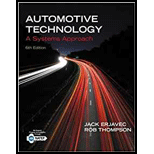
Automotive Technology (Custom)
6th Edition
ISBN: 9781337495356
Author: ERJAVEC
Publisher: Cengage
expand_more
expand_more
format_list_bulleted
Concept explainers
Textbook Question
Chapter 9, Problem 14RQ
True or False? The camshaft is always located in the engine block.
Expert Solution & Answer
Trending nowThis is a popular solution!

Students have asked these similar questions
3. The Figure shows the isometric view of a machine component along with the view from above
and the view from the left, draw the full sectional view from the front.
56
Draw here the full sectional view
90
40
(a)
32
56
B
32
How do I solve this task?A spring scale should have a capacity for 10kg. The tension spring is mounted with a weight that is a preload in the spring. Choose a spring with a maximum load of 50mm. What distance should the kg weight be and what the preload weight should weigh.F=Fo+c·fFo= preload weight (N)F=10·9.81 → F=98.1 N Trying with a spring 3823f=F- Fo /c → 98.1-9/1.090=81.74 mm
A gearbox consists of four gears. Dimension the gearbox for a gear ratio of 18:1. The gear ratio should be as even as possible. In the first stage, module 4, in the second stage module 5. All shafts are in the same plane. Calculate the distance between Da. Da=45mm Db=40mmu=ωin/ ωout= nin/ nout= dout/ din= Mout/ Min= Zout/ Zind=m·z)da=m·(z+2) (top diameters)df=m·(z-2.5) (bottom diameters)tooth limits z1 z2 13 13-16 14 14-26 15 15-45 16 16-101 17 17-1314 18 18- .......
Chapter 9 Solutions
Automotive Technology (Custom)
Ch. 9 - Prob. 1RQCh. 9 - Describe what takes place during the four strokes...Ch. 9 - As an engines compression ratio increases, what...Ch. 9 - What test can be performed to check the efficiency...Ch. 9 - Describe tappet noise.Ch. 9 - Which of the following statements about engines is...Ch. 9 - Which stroke in the four-stroke cycle begins as...Ch. 9 - True or False? In an HCCI engine, combustion...Ch. 9 - Which of the following is not a true statement...Ch. 9 - True or False? SAE mandates that engine, when...
Ch. 9 - Technician A says head gasket thickness has an...Ch. 9 - Prob. 12RQCh. 9 - The stroke of an engine is the crank throw half...Ch. 9 - True or False? The camshaft is always located in...Ch. 9 - Which of the following is an expression of how...Ch. 9 - While diagnosing the cause for blue smoke from the...Ch. 9 - Prob. 2ASRQCh. 9 - While determining the cause for air leaking out of...Ch. 9 - While diagnosing the cause for an engine having...Ch. 9 - While looking at the results of an oil pressure...Ch. 9 - A vehicle is producing a sharp, metallic rapping...Ch. 9 - While conducting an engine vacuum test; Technician...Ch. 9 - While determining the most likely problem of an...Ch. 9 - When a customer states that black exhaust smoke is...Ch. 9 - Technician A says that if an engine had good...
Knowledge Booster
Learn more about
Need a deep-dive on the concept behind this application? Look no further. Learn more about this topic, mechanical-engineering and related others by exploring similar questions and additional content below.Similar questions
- Question 2 a) Construct the signal flow graph (SFG) for the block diagram shown in Fig. Q2 (a) and C($) obtain the gain using Mason's formula. R(s) 04 -R() 01 0₂ 0 Hi h Sinded States Text Predictions On Accessibility Unavailable Fig. Q2 (a) H₂ CAarrow_forwardHow do you solve for the force acting on member BC?arrow_forwardA brake jaw, A is pressed against the drum, B. Calculate the brake arm, X(m₂).F= 250NBraking torque = 30Nmµ=0.35Around point A:Fm₂-Nm₁-µm₃=0N=Fm₂/m1+ µm₃MBrake =µ·D/2= µ·D/2MBrake =Fµm₂D/2(m₁- µm₃)(X)m₂=FµD/Mbrake·2(m1- µm₃)(X)m₂=250·0.35.0.3/30·2(0.250-0.35·0.06)=?I don’t get some likely value?arrow_forward
- Q7 (12 Marks) For the system shown in Fig.3: 1- Draw the overall block diagram. 2- Determine the transfer function (Pc(s)/E(s)). Orifice→ Ps Actuating error signs) Flapper Pb+Pb. Nozzle. A X+X+ Ri A I R2 ㅍ think +y Pc+PCarrow_forwardFigures 4: show a pneumatic controller. The pneumatic relay has the characteristic that pc=K pb , where K>0. What kind of control action does this controller produce? a. Derive the mathematical model for the system b. Derive the transfer function Pc(s)/E(s) -Solve step by step Orifice F+Ph R₁ Actuating error signal Flapper Nozzle. x+x F+Pe thinkarrow_forwardThe equation of the turning moment diagram for the three crank engine and the equation of the moment required by a machine connected to this engine are given below: Engine Torque Machine Torque T=10000-500 sin (40) T=10000+2000 sin (20) N.m N.m where radians is the crank angle from inner dead center and the mean engine speed is 300 rpm. It is required to select a proper flywheel (find the moment of inertia of the flywheel in kgm2) and then calculate the power of the engine if the total percentage fluctuation of speed of the flywheel is ±1% of the mean speed. Calculate the angular acceleration of the flywheel when angle is 45°.arrow_forward
- Design a cotter joint to support a axial load of 100kN . Carbon steel material selected whichhas Tensile stress = 100MPa Compressive stress =150MPa; Shear stress =60MPaarrow_forwardDesign a cotter joint to support a axial load of 100kN . Carbon steel material selected whichhas Tensile stress = 100MPa Compressive stress =150MPa; Shear stress =60MPaarrow_forwardI need all the derivations from Bohr's postulates in handwritten formarrow_forward
- 12. Figure Q12 shows a prospective design for a conveyor roller system, for transferring crates, one at a time. The system is made up of two parallel rectangular steel beams, built-in at one end and simply supported at the other, with closely spaced rollers mounted in-between, for the crate to pass over. a) Using Macaulay notation, carry out an analysis of the problem and calculate the deflection of the mid-length point of the beams when the crate is centrally located, midway between A and B. State any important assumptions used in your analysis. [20 marks] b) Comment briefly whether this would be the maximum deflection of the beams when the crate is centrally located. 2 m 8 m A Direction of travel Figure Q12 (side view, only one beam visible) Useful information I for each separate beam = 12 ×10 m² E for both beams = 210 GPa Weight of one crate = 800 N [5 marks] Barrow_forward11. A ring (side view shown in Figure Q11) has a circular solid cross-section of 5 mm diameter. The ring itself has a radius of R = 100 mm and a very narrow gap at point A, that allows the two free ends to be pulled apart by forces P, increasing the size of the gap. ○ P A Figure Q11 P a) Show that the total strain energy of the ring due to the applied forces is: U = 3πP²R³ 2EI [12 marks] b) Find the maximum bending stress produced if forces of P = 8 N are applied. [6 marks] c) What minimum force P would cause the material in the ring to yield and at which locations could this yielding begin to occur? Useful information E for the ring material = 75 GPa Oyield for the ring material = 190 MPa [7 marks]arrow_forwardQ2(15 Marks): From Fig. 2, Determine (a) mass equivalent in term x2, (b) stiffness equivalent in term x2, and (c) the natural frequency for the system in term x2. Note: (1) J Cylinder = mcr? J link (2) 2 3 Pulley, mass moment of inertia J Rigid link 1 (mass m₁), rotates with pulley. about O Cylinder, mass m Adherence to the symbols as in the question 152 153 xx(1) Fig. (2) m k₁ nimmunizmu Rigid link 2 (mass m₂)arrow_forward
arrow_back_ios
SEE MORE QUESTIONS
arrow_forward_ios
Recommended textbooks for you
 Automotive Technology: A Systems Approach (MindTa...Mechanical EngineeringISBN:9781133612315Author:Jack Erjavec, Rob ThompsonPublisher:Cengage Learning
Automotive Technology: A Systems Approach (MindTa...Mechanical EngineeringISBN:9781133612315Author:Jack Erjavec, Rob ThompsonPublisher:Cengage Learning Automotive TechnologyMechanical EngineeringISBN:9781337794213Author:ERJAVEC, Jack.Publisher:Cengage,
Automotive TechnologyMechanical EngineeringISBN:9781337794213Author:ERJAVEC, Jack.Publisher:Cengage,

Automotive Technology: A Systems Approach (MindTa...
Mechanical Engineering
ISBN:9781133612315
Author:Jack Erjavec, Rob Thompson
Publisher:Cengage Learning

Automotive Technology
Mechanical Engineering
ISBN:9781337794213
Author:ERJAVEC, Jack.
Publisher:Cengage,
Principles of Lubrication | Automobile Engineering; Author: Magic Marks;https://www.youtube.com/watch?v=MGbbSxZTdCQ;License: Standard Youtube License